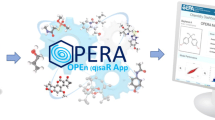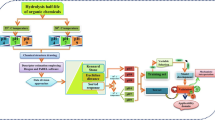Abstract
Hydrophobicity, as measured by Log P, is an important molecular property in assessing toxicity and carcinogenicity of disinfection by-products (DBPs). With increasing public health concerns of DPBs, there are considerable benefits in developing Quantitative Structure Activity Relationship (QSAR) models, capable of accurately predicting Log P, which could be used in health risk assessment of DBPs. In this research, Log P values of 46 halogenated alkanes, as one class of DBP compounds, were used to develop QSAR models for this class. Three molecular descriptors, namely, Energy of the Lowest Unoccupied Molecular Orbital (ELUMO), Number of Chlorine (NCl) and Number of Carbon (NC) were used in Multiple Linear Regression (MLR) analysis. The QSAR models developed were validated according to the principles set up by the Organization for Economic Co-operation and Development (OECD). Model Applicability Domain (AD) of the developed QSAR models was defined and mechanisms were interpreted. Considering large number of halogenated alkane compounds, the established QSAR models performed very well in terms of goodness-of-fit, robustness and predictability. The predicted values of Log P of DBPs by the QSAR models have correlation coefficient R2 from 81 % to 98 % with the observed Log P. The leverage approach by Williams plot was applied to detect and remove outliers. As a result, the correlation coefficient, R2, of the QSAR models increased by approximately 2 % to 13 %, before and after removing the outliers, respectively. The developed QSAR model was statistically validated for its predictive power of Log P by the Leave-One-Out (LOO) and Leave-Many-Out (LMO) cross validation methods.








Similar content being viewed by others
References
Edelbach DJ, Lodge KB (2000) Insights into the measurement of the octanol–water partition coefficient from experiments with acrylate esters. Phys Chem Chem Phys 2:1763–1771
Gramatica P, Papa E (2005) An update of the BCF QSAR model based on theoretical molecular descriptors, QSAR and Comb. Science 24(8):953–960
Gramatica P, Pilutti P, Papa E (2004) Validated QSAR prediction of OH tropospheric degradation of VOCs: splitting into training-test sets and consensus modeling. J Chem Inf Comput Sci 44:1794–1802
Hansch C, Leo A, Hoekman D (1995) Exploring QSAR - fundamentals and applications in chemistry and biology. American Chemical Society, Washington, DC
Lee PY, Chen CY (2009) Toxicity and quantitative structure–activity relationships of benzoic acids to pseudokirchneriella subcapitata. J Hazard Mater 165:156–161
Leo A, Hansch C (1999) Role of hydrophobic effects in mechanistic QSAR. Perspect Drug Discov 17:1–25
Liu N, Jiang GF, Guo CC, Tan Z (2009) Quantitative structure–activity relationship studies on ironporphyrin-catalyzed cyclohexane oxidation with PhIO. J Mol Catal A Chem 304:40–46
OECD (2007) Guidance document on the validation of (quantitative) structure–activity relationships [(Q)SAR] models, organisation for economic Co-operation and development, Paris
Padmanabhan J, Parthasarathi R, Subramanian V (2005) QSPR methods for polychlorinated biphenyls: n-octanol/water partition coefficient. Bioorg Med Chem 14:1021–1028
Pavan M, Worth A, Netzeva T (2005) Preliminary analysis of an aquatic toxicity dataset and assessment of QSAR models for narcosis, JRC report EUR 21479 EN. European Commission, Joint Research Centre, Ispra
Pontolillo J, Eganhouse RP. (2001) The search for reliable aqueous solubility (Sw) and Octanol-water partition coefficient (Kow) data for hydrophobic organic compounds: DDT and DDE as a Case Study. U.S. Geological Survey, Water-Resources Investigations Report 01–4201; USGS: Reston, VA
Renner R (2002) The Kow controversy. Doubts about the quality of basic physicochemical data for hydrophobic organic compounds could be undermining many environmental models and assessments. Environ Sci Technol 36:410A–413A
Suzuki T, Kudo Y (1990) Automatic Log P estimation based on combined additive modeling methods. J Comput Aided Mol Des 4:155–198
Tang WZ (2003) Physicochemical treatment of hazardous wastes. CRC Press, Boca Raton
United States Environmental Protection Agency (USEPA) (2003) Proposed stage 2 disinfectants and disinfection byproducts rule. Rep. No. EPA 815-F-03-006, Cincinnati
Zhao YH, Yuan X, Su LM, Qin WC, Abraham MH (2009) Classification of toxicity of phenols to tetrahymena pyriformis and subsequent derivation of QSARs from hydrophobic, ionization and electronic parameters. Chemosphere 75:866–871
Acknowledgments
The authors would like to appreciate the Dean’s Infrastructure Grant to WZT from the College of Engineering and Computing, Florida International University, Miami, Florida. The grant made this research possible for Dr. Rena Chen to complete her doctoral dissertation by providing the needed hardware and software in Dr. Tang’s research laboratory.
Author information
Authors and Affiliations
Corresponding author
Rights and permissions
About this article
Cite this article
Chen, R.Z., Tang, W.Z. & Sillanpää, M. Prediction of Log P of Halogenated Alkanes by Their ELUMO and Number of Chlorine and Carbon. Environ. Process. 3, 73–91 (2016). https://doi.org/10.1007/s40710-016-0135-5
Received:
Accepted:
Published:
Issue Date:
DOI: https://doi.org/10.1007/s40710-016-0135-5




